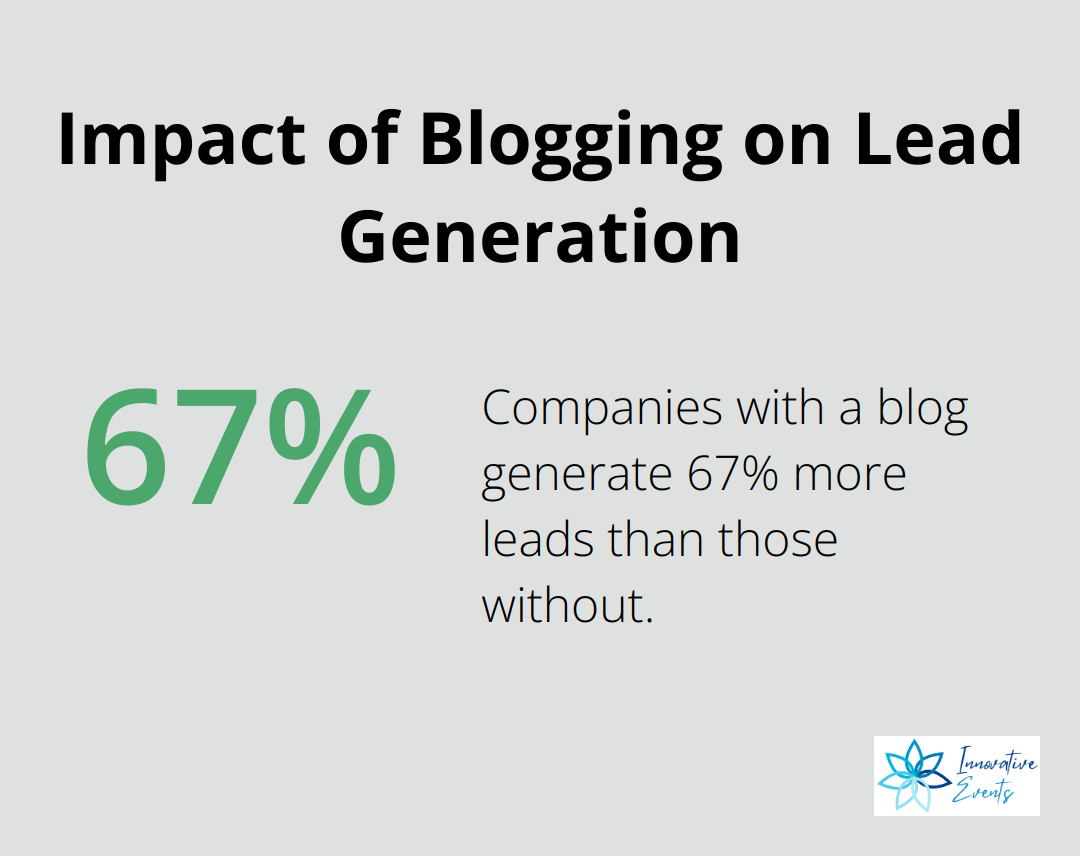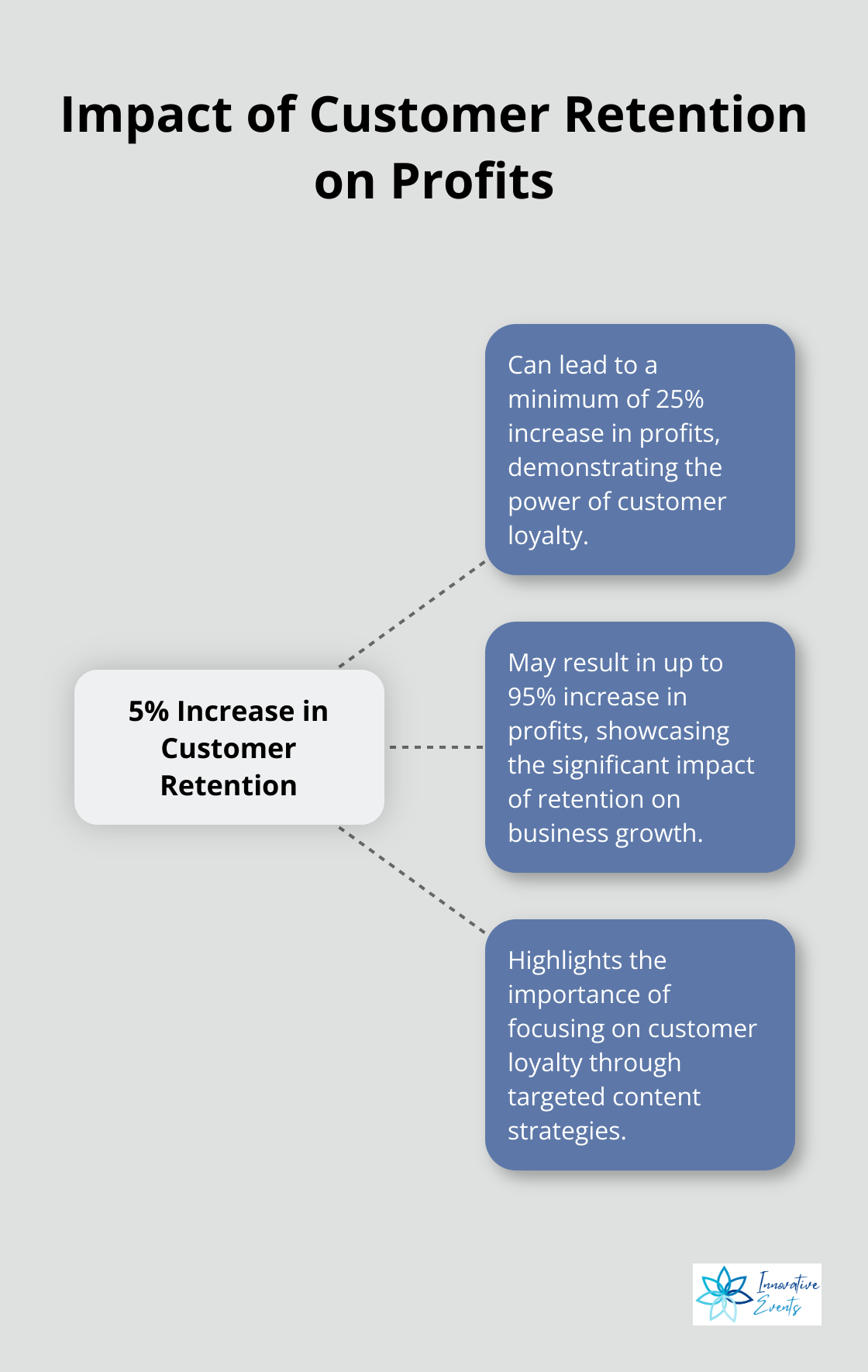Content marketing has become a cornerstone of modern business strategies. At Innovative Events, we’ve seen firsthand how powerful it can be when done right.
In this post, we’ll explore examples of great content marketing that have set the bar high. These success stories will inspire you and provide practical insights for your own content marketing efforts.
How We Measure Content Marketing Success
The Numbers That Matter
At Innovative Events, we understand the importance of measuring content marketing success to refine strategies and achieve business goals. Content marketing success isn’t about viral hits or fleeting popularity-it’s about driving real business results. Key performance indicators (KPIs) such as conversion rates, lead quality, and sales pipeline growth are essential. For example, companies with a blog generate 67% more leads than those without, underscoring the power of consistent content creation.

Engagement metrics also play a vital role. Time on page, social shares, and comments indicate how well your content resonates with your audience. The most successful B2B content marketers (88% of them) measure content performance, highlighting the importance of data-driven strategies.
Short-Term Wins vs. Long-Term Gains
While quick wins can boost morale, long-term metrics often provide a more accurate picture of content marketing success. SEO rankings, for instance, take time to build but can drive sustained organic traffic. Pages ranking in the top 10 of Google are, on average, 2+ years old-a testament to the value of patience in content strategy.
Customer lifetime value (CLV) is another critical long-term metric. It’s not just about acquiring customers; it’s about retaining them. Increasing customer retention rates by 5% can increase profits by 25% to 95% (a compelling reason to focus on customer loyalty through content).

Aligning Content with Business Objectives
Your content should serve your business goals. Whether you aim for brand awareness, lead generation, or customer retention, each goal requires different metrics. For brand awareness, reach and impressions might take center stage. For lead generation, form fills and email sign-ups become the focus.
One of our clients saw an increase in qualified leads after we helped them realign their content strategy with their sales funnel, demonstrating the power of strategic content alignment.
The Role of Multi-Channel Analytics
In today’s digital landscape, content doesn’t exist in a vacuum. It’s distributed across multiple channels, each with its own set of metrics. Social media engagement, email open rates, and website traffic all contribute to the overall picture of content performance.
Tools like Google Analytics, social media insights, and marketing automation platforms allow for a comprehensive view of content performance across channels. This multi-channel approach enables marketers to understand how different pieces of content contribute to the customer journey.
Continuous Improvement Through Data
The most successful content marketers don’t just create content for the sake of it. They create content with a purpose, measure its impact, and continuously refine their approach based on data-driven insights. This iterative process turns content into a powerful business asset.
As we move forward, let’s explore some real-world examples of content marketing success. These case studies will illustrate how top brands have leveraged these measurement principles to create truly impactful content strategies.
Real-World Content Marketing Wins
At Innovative Events, we’ve witnessed the transformative power of effective content marketing. Let’s explore some standout examples that showcase the impact of strategic content creation and distribution.
Red Bull’s Adrenaline-Fueled Media Empire
Red Bull has redefined content marketing by creating a media powerhouse that extends far beyond energy drinks. Their strategy focuses on producing high-quality, adrenaline-pumping content that aligns perfectly with their brand image.
Red Bull Media House, their content arm, produces everything from feature films to live sports events. The Red Bull Stratos space jump, which saw Felix Baumgartner freefall from the stratosphere, exemplifies how Red Bull creates content that people actively seek out, rather than interrupting their audience with traditional advertising. This event showcased how experiential marketing can reach new heights-literally.
The key takeaway? Create content that your audience genuinely wants to consume, even if it doesn’t directly relate to your product.
HubSpot’s Inbound Marketing Revolution
HubSpot has built its entire business model around the concept of inbound marketing, and their content strategy reflects this approach. They’ve created a vast library of free resources, including blog posts, ebooks, templates, and tools, all designed to help businesses improve their marketing efforts.
Their State of Inbound report has become a go-to resource for industry insights. HubSpot’s Marketing Strategy Survey provides valuable data on the most important marketing trends, helping marketers stay ahead of the curve.
HubSpot’s success stems from their commitment to educating their audience. They provide genuinely helpful content, positioning themselves as thought leaders in the marketing space, which drives both brand awareness and lead generation.
Airbnb’s User-Generated Storytelling
Airbnb’s content marketing strategy leverages the power of user-generated content to tell authentic stories about travel and human connection. Their blog, Airbnb Magazine, features stories from hosts and travelers, showcasing unique experiences and destinations.
One of their most successful campaigns, #WeAccept, combined user stories with a powerful message of inclusion. The campaign sparked conversations about diversity and acceptance.
Airbnb’s approach shows how brands can tap into their community to create compelling content. They amplify the voices of their users, building a strong emotional connection with their audience.
Blendtec’s Viral Video Success
Blendtec’s “Will It Blend?” video series exemplifies how creativity and humor can drive viral content. The series features Blendtec’s founder attempting to blend various objects (from iPhones to golf balls) in their industrial-strength blenders.
This campaign’s success lies in its ability to showcase the product’s capabilities in an entertaining and shareable format. It reminds us that even B2B companies can create engaging content that resonates with a wide audience.
These case studies demonstrate diverse approaches to content marketing. Whether you create a media empire like Red Bull, educate your audience like HubSpot, leverage user-generated content like Airbnb, or think outside the box like Blendtec, the key is to provide value to your audience while aligning with your brand identity.
Now that we’ve explored these inspiring examples, let’s examine the key strategies that underpin successful content marketing campaigns.
How to Craft a Winning Content Strategy
Know Your Audience Inside Out
The foundation of any successful content strategy is a deep understanding of your target audience. Use tools like Google Analytics to analyze your website traffic and gain insights into your visitors’ demographics, interests, and behavior. Social media analytics can also provide valuable information about your followers’ preferences and engagement patterns.
Conduct surveys and interviews with your existing customers to understand their pain points, goals, and content preferences. This qualitative data can prove invaluable in shaping your content strategy.
Create Content That Solves Problems
Once you understand your audience, focus on creating content that addresses their specific needs and challenges. Top-performing B2B content marketers prioritize their audience’s informational needs over promotional messages.
For example, if you target small business owners, you might create a series of how-to guides on topics like “5 Ways to Improve Cash Flow” or “The Ultimate Guide to Small Business Tax Deductions.” These types of content provide immediate value to your audience while positioning your brand as a helpful resource.
Diversify Your Content Formats
While blog posts are a staple of content marketing, don’t limit yourself to just one format. Experiment with different types of content to engage your audience in various ways:
- Video content: Video marketing appears to be delivering an excellent ROI for businesses.
- Podcasts: 41% of Americans listen to podcasts monthly, offering a unique way to connect with your audience.
- Infographics: These visual representations of data can increase web traffic by up to 12%.
- Interactive content: Quizzes, calculators, and assessments can boost engagement and provide valuable data about your audience.

Optimize for Search Engines
To ensure your content reaches your target audience, it needs to be discoverable. Implement SEO best practices in your content creation process:
- Conduct keyword research to identify terms your audience searches for.
- Optimize your content with relevant keywords, meta descriptions, and title tags.
- Create high-quality, in-depth content that answers user queries comprehensively.
- Build a strong internal linking structure to help search engines understand the hierarchy of your content.
Measure and Iterate
Content marketing is an ongoing process of creation, measurement, and optimization. Use tools like Google Analytics, SEMrush, or Ahrefs to track key metrics such as organic traffic, time on page, bounce rate, and conversions.
Regularly analyze your content performance to identify what works and what doesn’t. For instance, if you notice that your video content consistently outperforms your blog posts in terms of engagement, you might consider allocating more resources to video production.
A successful content strategy doesn’t require creating more content-it requires creating the right content for your audience and business goals. Follow these strategies and continuously refine your approach to develop a content marketing program that drives real business results. Remember to maintain a life balance while pursuing your content marketing goals, and consider using stress management apps to help manage the demands of content creation and strategy implementation.
Wrapping Up
Successful content marketing campaigns share common elements that set them apart. The examples of great content marketing we explored demonstrate the power of understanding your audience and delivering value consistently. These strategies prioritize audience engagement over direct product promotion, creating content that resonates and solves problems.
To implement these strategies, start with a deep understanding of your audience’s needs and preferences. Use data-driven insights to inform your content creation and distribution strategies. Diversify your content formats, optimize for search engines, and measure performance regularly to refine your approach.
At Innovative Events, we apply these principles to our personalized, integrative lifestyle program for busy executives. Our approach mirrors successful content marketing – it’s tailored, data-driven, and focused on delivering long-term value (just like effective content strategies).

